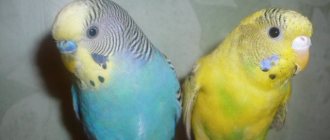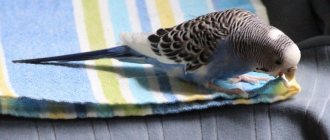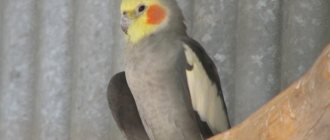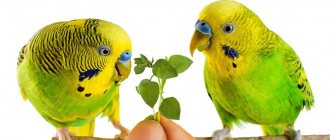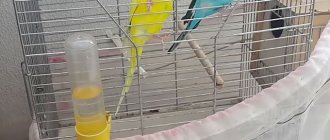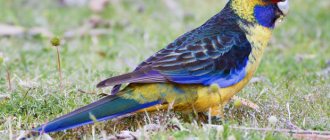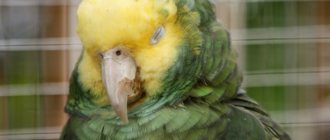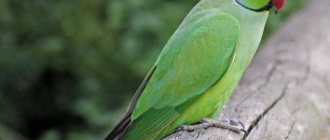Necessary conditions for breeding
Firstly, breeding budgerigars assumes that their owner understands the sexual characteristics of these beautiful birds and will not cage individuals of the same sex. Two females will quarrel and lead to the idea that the pair is unsuccessful. But males can get along quite peacefully together (until they have a girlfriend). Inexperienced owners cannot understand why they do not begin to reproduce. And it’s all about purely “brotherly” relations.
The age of the female and male should not be less than 2 and not older than 8 years. Puberty during this period has already gained momentum. In a year, one such pair is capable of producing three broods. Older individuals reproduce offspring with difficulty, and they are weak and sick. A very young female may not be able to withstand such a load and die.
Necessary conditions include:
- health status;
- illnesses that they suffered before (budgerigars mate only in a healthy state). Not only sick, but also recovering birds cannot become parents;
- balanced nutrition for feathered pets;
- length of daylight hours;
- the air temperature in the room where the cage is located should be between 24 and 26 degrees Celsius;
- availability of a nesting house;
- females should not be obese, they are prone to tumors and fall off their eggs;
- During molting periods there is no point in expecting offspring.
Reasons why the clutch turned out without fertilized eggs or with frozen
When there are one or two frozen eggs in the clutch, there is no need to worry. Even due to inexperience, the female may not have warmed all the eggs evenly. If all the offspring died, it is worth thinking about the reasons.
These could be infectious diseases of parrots, improperly formulated bird nutrition, poor-quality water, genetic incompatibility of parents, inappropriate humidity in the apartment, or the female is not able to hatch eggs normally.
As for unfertilized eggs, the most common reason is that the birds were not properly prepared by the breeder. But it happens that the reason lies in health problems in one or both parrots. Even the wrong location and quality of the perches can affect the result.
Matching
To be successful in breeding budgies, you should pay attention not only to the age and health of the birds. It is advisable to select future parents of chicks from different families that are not united by common genetics. This will avoid anomalies in the health of the offspring.
Some experts allow males and females to find their own mates, keeping a whole group of different-sex parrots in one large cage. When they find a companion and partner on their own, this will save the owner from the hassle and unsuccessful attempts. Because there are cases when a female behaves aggressively with her intended partner, and they do not have the prerequisites for mating and offspring. Time is lost, and the owner needs to go and look for the next candidate, hoping for success on the second or third try.
They suggest checking the unity of characters when meeting in the following way:
- Place the prospective couple in adjacent cages.
- If the candidates are attracted to each other, let them fly together on neutral territory.
- Launching birds into one cage.
The location of the male budgerigar and the female can be seen by the following signs:
- he tries to clean her feathers, feeds her from his beak, coos like a dove;
- she nods her head and kisses the future dad of their children. Even if there are several other parrots in the cage, the female stays close to her gentleman.
Male courtship
During the mating season, the male's cere becomes a rich blue color, while the female's is brown, even slightly enlarged. This is a sign of raging hormones. The male's courtship becomes more intrusive; some females hardly eat until the male feeds them, although they themselves are not yet sitting in the nest.
Photo: Matt Francey
It is very interesting to watch the wavy couple cooing before mating. The male begins to actively nod his head, chirp, and dancing and chatting begin - the parrot knocks with its beak on all objects and on the beak of the female. Sometimes the female takes part in the dance. Making all kinds of sounds, the male does not forget to treat the young lady with food from his beak. This ritual seems to confirm the seriousness of the male’s intentions. After all, after the female goes to the nest to incubate the eggs, the male becomes the main breadwinner and guard.
The right time for breeding
Experts say that the best time for parrots to start breeding is late spring. The daylight hours have increased and reach 15 hours, there is a lot of green food around and enough warmth. Until early autumn, you can plant parrots on clutches. It’s more difficult in winter, as additional lighting needs to be installed.
Experienced ornithologists do not advise preparing pairs for future offspring in early spring. The past winter has weakened them. The mating season for budgerigars will pass, but healthy offspring will not be produced. The body of the expectant mother needs vitamins in sufficient quantities. And in spring and summer, you can absolutely safely feed her with greens up to three times a day.
Preparing the cage and nest
Breeding budgies requires careful preparation of the cage and all its elements. For example, a female, preparing for maternal responsibilities, begins to gnaw on everything she can reach. To avoid damage to cage parts and other accessories, it is recommended to put a vitamin stone and several twigs. Let her fulfill her need on them.
Each specialist recommends his own cage sizes. However, the minimum parameters are 40x30x40 cm. Insufficient space can interfere with the appearance of offspring. And if it is born, they may experience the aggression of their parents.
The cage is placed at eye level of the owner, this makes the birds safer and calmer. You should not place it near a microwave oven or gas stove.
The room where you decide to keep the parrots should be well ventilated, but at the same time avoid drafts. As soon as the parrots begin the nesting period, do not move the cage, do no repairs in this room, and do not produce sounds unusual for birds.
For the hygiene of the mother and future offspring, disinfection and sterilization are necessary: wipe with “White” and rinse the drinking bowl, feeder, and cage in warm water. The nest is washed using baby liquid soap, dried and heated in the oven at a temperature of about 130 degrees for 40 minutes. Mix sawdust with chamomile. This will repel gamas ticks.
Proper feeding
During the breeding season, the female needs a huge amount of nutrients. The formation of eggs and the normal development of embryos requires special cuisine. Store-bought food does not provide this. The owner of the pair should think about additional nutrition as a source of essential elements and vitamins.
Experts recommend mixing carrots with an egg and a source of calcium. The female tolerates laying well with this diet. But the abundance of this mixture can lead to illness. Therefore, it is better to give it every other day.
Feeding budgies with sprouted grain is recommended not only during the nesting period. For feathered friends, this is an indispensable source of microelements and vitamins. The owner should always add calcium-containing foods, vegetables and fruits to the cage.
When laying eggs, soft food is excluded, and the volume of grains is doubled. Parrots get the necessary carotene from pumpkin, carrots and red sweet peppers.
When the chicks hatch, the parents are given yeast with phosphorus and calcium gluconate. And the chicks first feed on milk from the female’s crop. Afterwards they are transferred to grain.
House installation
2 weeks after the preparation stage, a house must be installed in the cage. The optimal size of the house is 20 x 20 x 15 cm.
Don't worry if the female doesn't react and doesn't go there. In a couple of days she will get used to it, begin to become interested and build a nest there.
For this she will need building material. Sawdust, dry grass and thin twigs are placed in the cage. As a preventive measure against parasites, you can add dry medicinal chamomile.
The female will independently carry the material into the house and arrange the nest; she should not be helped.
Nesting period
The nesting period includes several important moments: from mating to the appearance of chicks. Depending on whether mating took place quickly or within two weeks, the wait for the young can last up to a month.
Pairing
Ornithologists note that mating of budgerigars can be one-time and sufficient for fertilization and the appearance of offspring. As a rule, the owners do not notice the rapid mating process. But sometimes mating games of budgies are repeated within 1-3 weeks.
Behavior of a pregnant female
After mating, the female's behavior begins to change. Ready to lay her eggs, she begins to familiarize herself with the nesting site. First, she looks at the nest from afar, stretching her neck. After some time, feeling that there is nothing to be afraid of, the female begins to slowly approach him. Depending on her character traits, sooner or later the female flies inside the house and begins to settle in there: gnawing on the walls and throwing out what, in her opinion, is unnecessary.
Hatching offspring
It is necessary to ensure that none of the fertilized eggs is left unwarmed. Hatching lasts up to three weeks. If during this period some of the eggs do not hatch, they are removed. It happens that some chicks die after hatching. To detect and remove them, the house is checked 2-3 times a week.
Determination of egg quality
In simpler terms, this procedure is called ovoscopy. A week after laying, the eggs are checked. Fertilized ones have a matte tint, while unfertilized ones have some gloss in appearance and the color is mottled or yellowish-white.
Among the known defects are the following:
- blood clots in the egg;
- the embryo dries to the shell wall;
- the yolk and white are mixed;
- foreign objects enter the egg while still in the female’s oviduct;
- the air chamber in the egg moves;
- mold spots inside.
The appearance of chicks
The chicks are born blind and very weak. The body is completely naked, the opening of the eyes occurs after 6 or 7 days. But they can concentrate their gaze only 3 days later.
If a mother behaves aggressively towards her children, the babies are immediately removed. The female begins to leave the nesting site about two weeks after the chicks appear and returns to her usual quiet life.
The first chick hatches much earlier than the last one. The gradual laying of eggs is the reason for the extended hatching and maturation of the chicks.
The appearance of chicks
The incubation period lasts 16-20 days. Chicks are born every other day. At this time, it is especially important to maintain air humidity and avoid heat and dryness.
The thing is that under the shell there is a thin film that can dry out in the heat. In this case, the chick will not be able to break it and will die.
At birth, chicks weigh only 1-1.5 grams. They grow and develop quite quickly. If the clutch was large, then when the last chick appears, the first ones are already quite large and can crush the babies.
The chicks are born naked, blind and helpless. They are very weak, cannot support their heads and lie on their backs.
Why do budgies not reproduce?
One of the reasons is that the birds did not show mutual sympathy for each other. But there are other reasons:
- the male is much younger than his girlfriend;
- the rules for introducing parrots are not followed by their owner;
- small cell size.
Reproduction of budgies is not such a simple process. The concept of “met and live, reproducing offspring” does not guarantee success. People put up with cramped spaces and other inconveniences as they build their lives. Birds, on the other hand, require decent conditions so that the family can take place, and they decided that it was time to “have” children.
However, the author of the article would like not only to share his experience, but also to receive several useful additions from experts in the topic of breeding budgerigars. To do this, please leave your opinion in the comments under the article, and also join our VKontakte group.

